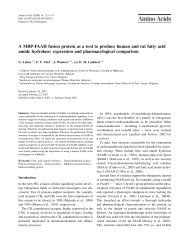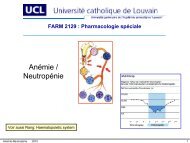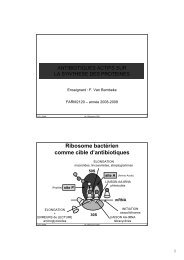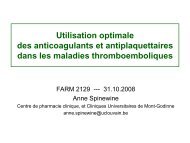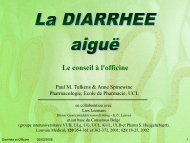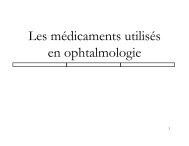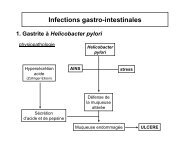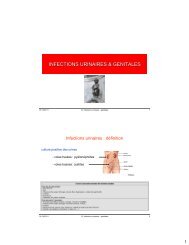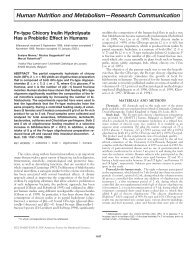Role of apoptosis for mouse liver growth regulation and tumor ...
Role of apoptosis for mouse liver growth regulation and tumor ...
Role of apoptosis for mouse liver growth regulation and tumor ...
Create successful ePaper yourself
Turn your PDF publications into a flip-book with our unique Google optimized e-Paper software.
Table 3<br />
Hepatocellular apoptoses in C3H/He <strong>and</strong> C57Bl/6J mice<br />
Strain Day Control (%) PB treatment<br />
(7 days) (%)<br />
W. Bursch et al. / Toxicology Letters 149 (2004) 25–35 29<br />
PB withdrawal<br />
(7 days → 0 <strong>for</strong><br />
2–14 days) (%)<br />
NAF treatment<br />
(7 days) (%)<br />
NAF withdrawal<br />
(7 days → 0 <strong>for</strong><br />
2–7 days) (%)<br />
C57Bl/6J 7 0 (0–0.17) 0 (0–0.17) 0.2 (0.13–0.41)<br />
9 0 (0–0.17) 0 (0–0.17)<br />
11 0.02 (0–0.17)<br />
14 0 (0–0.17) 0 (0–0.17)<br />
21 0 (0–0.17) 0.12 (0.06–0.29) 0 (0.06–0.29)<br />
9–21 FR 0.04 (0–0.14)<br />
C3H/He 7 0.02 (0–0.17) 0.03 (0–0.17) 0.08 (0–0.17)<br />
9 0.02 (0–0.17) 0.08 (0–0.17)<br />
11 0.02 (0–0.17)<br />
14 0 (0–0.17)<br />
21 0 (0–0.17) 0 (0–0.17)<br />
9–21 FR 0.05 (0–0.14)<br />
Treatment: see legend to Table 1. Liver specimens were cut into 4–5 mm thick slices <strong>and</strong> fixed with Carnoy’s solution <strong>and</strong> processed <strong>for</strong><br />
histological analysis as described in detail elsewhere (Grasl-Kraupp et al., 1994). Apoptoses were counted in hematoxylin <strong>and</strong> eosin (H&E)<br />
stained sections: hepatocytes with chromatin condensation typical <strong>of</strong> early stages <strong>of</strong> <strong>apoptosis</strong> as well as intra- <strong>and</strong> extracellular apoptotic<br />
bodies, with or without visible chromatin were recorded; their total number was expressed as percentage <strong>of</strong> the total number <strong>of</strong> hepatocytes<br />
scored in the respective cell population. The reliability <strong>and</strong> sensitivity <strong>of</strong> this procedure <strong>for</strong> quantitative determination <strong>of</strong> apoptoses has been<br />
verified (Chabicovsky et al., 2003). Data <strong>of</strong> two experiments are combined. means <strong>and</strong> 95% confidence limits (in brackets) are given. PB<br />
or NAF (7 days): animals sacrificed 1 day (day 7) after last treatment; PB or NAF (7 days) → 0: animals sacrificed two (day 9), four (day<br />
11), seven (day 14) or fourteen (day 21) days after PB- or NAF-withdrawal; means <strong>of</strong> 5–6 animals are given. FR: food restriction along<br />
with PB-withdrawal. Data <strong>of</strong> day 9–14. i.e. 2,4,7 days after PB withdrawal <strong>and</strong> food restricton are summarized, in total data <strong>of</strong> 26 animals.<br />
the occurrence <strong>of</strong> apoptoses, PB-pretreated mice were<br />
subjected to a 40% food restriction (FR) along with<br />
PB-withdrawal; FR has been previously shown to induce<br />
apoptoses in normal, hyperplastic as well as preneoplastic<br />
cell populations <strong>of</strong> rat <strong>liver</strong> (Grasl-Kraupp<br />
et al., 1994; Kolaja et al., 1996a; Hikita et al., 1998;<br />
Tomasi et al., 1999). Likewise, in C57Bl/6J×C3H F1<br />
mice subjected to food restriction an increase in apoptotic<br />
activity was reported (James <strong>and</strong> Muskhelishvili,<br />
1994; Kolaja et al., 1996a). In our study, body weight<br />
<strong>of</strong> FR-animals decreased steadily within the first week<br />
<strong>of</strong> food restriction, reaching the lowest levels (approx.<br />
70% <strong>of</strong> the initial body weight) within 7–9 days. Liver<br />
weight decreased by approx. 55%–60% within 1 week<br />
<strong>of</strong> FR. Surprisingly, the hepatic DNA content was not<br />
affected by FR—even food restriction <strong>for</strong> 14 days did<br />
not result in a significant lower <strong>liver</strong> DNA content as<br />
compared to feeding animals ad libitum (not shown).<br />
Accordingly, histological analysis revealed no significant<br />
increase in apoptotic activity at all time points<br />
investigated (2, 4, 7, 14 days FR; Table 3). In summary,<br />
<strong>mouse</strong> <strong>liver</strong> hypertrophy induced by PB or NAF<br />
is completely reversible within a few days after cessa-<br />
tion <strong>of</strong> treatment, similar to previous observations (<strong>for</strong><br />
review—Schulte-Hermann, 1974; Bursch et al., 1992;<br />
Huber et al., 1996). In contrast to hypertrophy, the enhanced<br />
DNA content <strong>and</strong> ploidy persisted <strong>for</strong> at least<br />
14 days after PB or NAF withdrawal <strong>and</strong> no increase<br />
<strong>of</strong> apoptoses occurred. Furthermore, food restriction<br />
did not facilitate the occurrence <strong>of</strong> <strong>apoptosis</strong> in <strong>mouse</strong><br />
<strong>liver</strong>. Thus, the present findings <strong>of</strong> the short-term<br />
experiments strongly suggest that <strong>mouse</strong> hepatocytes<br />
do not enter <strong>apoptosis</strong> as readily as rat hepatocytes<br />
under these conditions. It should be emphasized that<br />
this conclusion applies to both compounds studied,<br />
namely PB <strong>and</strong> NAF, which exert their action on hepatocytes<br />
through different receptor-signal transduction<br />
pathways (O<strong>liver</strong> <strong>and</strong> Roberts, 2002). Moreover,<br />
other in vivo as well as cell culture studies revealed<br />
that <strong>mouse</strong> hepatocytes are much less sensitive to the<br />
pro-apoptotic action <strong>of</strong> TGF-1 as compared to rat<br />
hepatocytes (Parzefall et al., 2002; Chabicovsky et al.,<br />
2003). In conclusion, the present short-term studies<br />
reveal no difference with respect to the occurrence <strong>of</strong><br />
<strong>apoptosis</strong> during <strong>liver</strong> regression among the <strong>mouse</strong><br />
strains under study, but add support to observations



